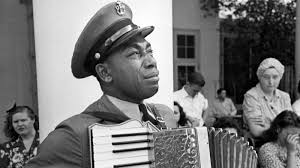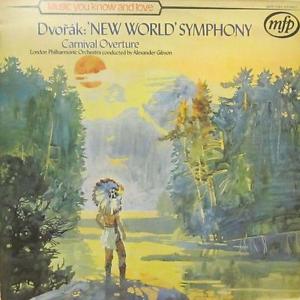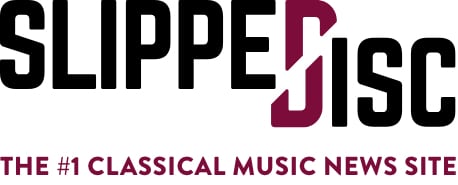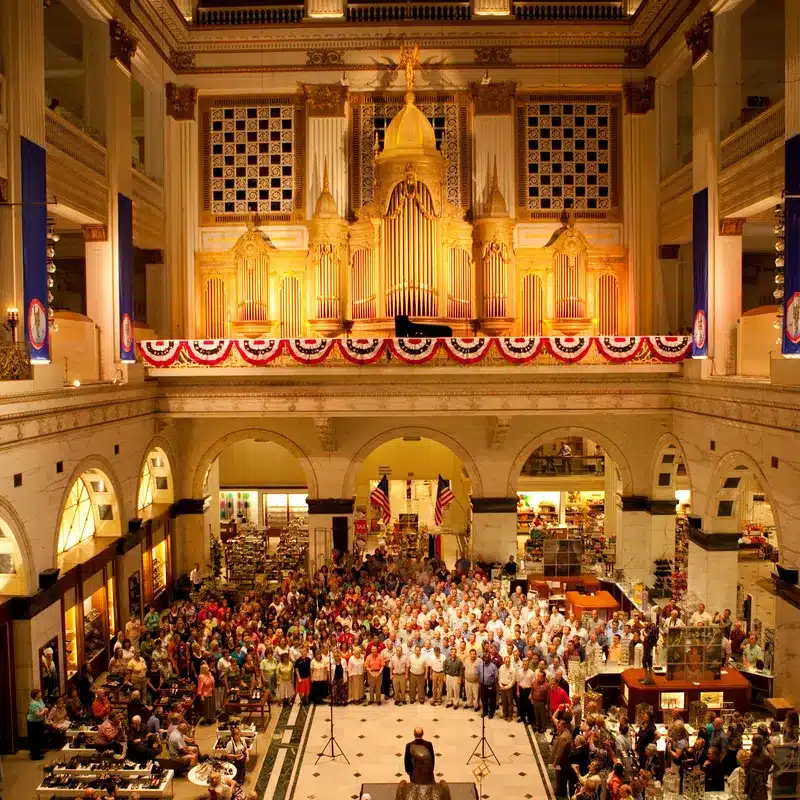So you think Dvorak’s ‘Going Home’ is an Afro-American tune?
mainThe Boston Camerata founder Joel Cohen is about to put us right:
It’s that holiday time of year, and to celebrate Thanksgiving, National Public Radio recently ran a feature segment about a bit of iconic Americana, namely the famous „Going Home“ theme from Antonin Dvorak’s „New World“ Symphony, which the famous Czech composer wrote during his American stay, circa 1892-93. It’s a magnificent and instantly memorable tune, stated at the beginning of the Symphony’s second, Largo, movement by a deeply expressive English horn against a background of sustained string harmonies.
When this writer was in grade school, in Providence, Rhode Island, circa 1949, he was told by his music teacher that the melody was inspired by, or actually was, a „Negro“ spiritual, and was representative of the profound soulfulness of the slaves and their descendants.
The NPR piece I caught on the radio a few days ago recycled, more or less, the fable I was told as a
child, and which seems to have surrounded the Dvorak Largo since, pretty much, its inception. The
Largo melody, said NPR, was „inspired by black spirituals.“
A mis-statement, but in all fairness, that was kind of what foxy old Dvorak had himself suggested about the themes in his symphony. Nonetheless, the truth will out. My dear fellow Americans (and other citizens of our strange, fascinating world), that tune, wonderful as it may be, and even though in grade school I was encouraged to sing it with the unspeakable „Massa dear, Massa dear“ lyrics, was not the least bit African-American. That fact, though barely acknowledged, has now been abroad in the land for a certain number of years, ever since soprano/scholar Anne Azéma identified the white gospel model,
and the Boston Camerata recorded it for a French record label in the late 1990s (re-issued circa 2008 by Warner Classics). And yet, somehow, the old, Massa meme continues to circulate.

Here’s the real story: Dvorak’s inspiration was a rollicking gospel hymn with a Christmas text, „Jesus the Light of the World,“ bearing at its foot the legend „Copyright 1890 by Geo. D. Elderkin. “ He borrowed/rewrote measures one to eight of Elderkin's song for the Largo theme. The copyright date for the model, we need not stress, reads only a couple of seasons before the great composer got to work on his New World masterpiece. To prime his creative pump for the Largo, the Czech master did not need to go to a plantation to hear the workers’ prayers, as was once suggested to me in third grade; he simply needed walk out of his lower Manhattan dwelling, head to a music store, and pick up a printed anthology of gospel songs. Which, we must now assume, he did.
Contrary to the „Negro“ myth, therefore, it was white on white for the Dvorak Largo and its model/inspiration. The story is not over, however. There is still an important, African-American piece to this tale.
Both the original Elderkin song, with the Christmas text „Hark the Herald Angels Sing“ and the Dvorak adaptation/rewrite from the Largo movement, were later taken up and adopted by African-American
congregations. The Dvorak version became an actual spiritual/sacred song, „Going Home.“ And the original „Hark the Herald Angels/Jesus the Light of the World“ continued in use, and, unremarked by NPR commentators and so many others, continues to be sung to this day. What is odd to me is the separateness of these two streams. On the one hand, you have an „official,“ erstwhile „Negro“ theme, composed in reality by an eminent, Central European symphonic master, serving, despite its non-American paternity, as a kind of symbolic icon of Americana.
It’s not black music but has been presented, for several generations now, as a somehow-respectable representation or avatar of black music.
On the other hand, you have this very energetic, authentic, American gospel song, Christmas-themed, continuing in the African-American church tradition. And no-one in over a century, or almost no-one, seems to have picked up on, or celebrated, their kinship: the pseudo-black song, and the white-loved- by- black-people original. But they are kinfolk, and they are both, like so much that is American, of mixed heritage. And perhaps celebrating their shared genetic code is one small step towards breaking down some racial and cultural barriers. Happy holidays! Or, perhaps, veselé Vánoce.
Amesbury, Ma. 11/2018

Discuss.





What I find interesting in this article is that, speaking personally, even the liner notes on oldest recording of the New World Symphony that I owned (probably Kubelik/Chicago Symphony on Mercury, circa 1952, which alas grew to be too scratched to retain) made it plain that there were no genuine “folk” tunes in the piece, just Dvorak’s efforts to show that American-sourced music could be absorbed and “symphonized” just as Czech-sourced music could.
So I at least grew up under no illusions that “Goin’ Home” was a genuine spiritual. And it is not as if I grew up in at atmosphere of extreme musical sophistication.
We know Dvorak was familiar with the general sound and tone of slave “sorrow songs” via his friend and associate Harry Burleigh who was the grandson of a slave. But perhaps he could not perceive if a given song was actually composed as an “in the style of” sorrow song versus the genuine article.
It does not seem too surprising or shocking that Dvorak might have heard a piece of composed and published music and assumed it had a folk origin that he could feel free to borrow. R. Strauss made that blunder after all when he wrongly thought “Funiculi, Funicula” was a genuine Italian folks song which he wove (Dvorak-like!) into his Italian Symphony.
And after all that study of African-American and American Indian music, he wrote a symphony that, to Czech ears, sounds — Czech! Every melody in the symphony could plausibly have been derived from Czech folk music (or Scottish, for that matter). Decades before ethnomusicology came into being, Dvořák unknowingly discovered that folk music traditions all over the world share some common DNA.
Perhaps the larger message is that all national identities are largely artificial constructs. This is why music is always important for potentates and nation states, it creates a sense of unity and power.
“Americana” is a lot of different things that over the years have facilitated the transformation of immigrants looking for a new life in America into Americans. You wear a cowboy hat, drive a big car, develop a taste for burgers and sing the anthem at sports events, add gratitude and love for your new home and voilá – you got yourself a new American (even if he maintains his accent). It is much more difficult to turn yourself into a Frenchman, a German, a Russian…
Turning immigrants into Americans is what made America Great. And music played a big role.
Too bad that those who want to make it great again have forgotten that.
A lovely sentiment at the end. Here’s to more steps, however small, toward humanity.
Hmm… Looking at the Elderkin version (easily findable by Googling “Jesus the Light of the World” and searching “images”) the only similarity I see is the first few notes, repeated in the next phrase.
But it was enough to get Dvořak inspired. I’m happy with that.
Not so fast. We know that Harry Burleigh sang African-American spirituals for Dvorak at the National Conservatory. I know of no reason not to think that Going Home was among them. No serious researcher of any folk music restricts themselves to publications with copyrights.
It is far more interesting to know about Dvorak’s stay in Spillville, Iowa, and his contact with American Indian music and how that affected his “American” string quartet and other works. You can find a good article about it in Minnesota History magazine archives at the Minnesota Historical Society, by Lionel Davis.
A copyright by itself does not prove the origin of an old spiritual song. In this instance, Mr Elderkin copyrighted his arrangement of a well known spiritual song handed down by oral tradition.
Pursuant to the article, History of Hymns: “Jesus, the Light of the World” by Jan McNair: “It is not clear if Elderkin composed the music. Carl Daw, in Glory to God: a Companion, surmises that Elderkin’s song may have come from an oral tradition of songs that used similar tunes, but changing stanzas. He identifies nine songs that use a melody, response, and refrain similar to Elderkin’s “Hark, the Herald” setting but each with different stanzas. This tune was apparently well known. The first and third lines of the stanzas were unique to each setting, with lines 2 and 4 consistently the response, “Jesus the Light of the World.” The refrain, melodically and rhythmically similar in each, was the oft used “Walk in the Light” tune. In the first edition, Elderkin includes “arr.” by his initials in the credit line for both text and tune. It is interesting to note that he copyrighted this song, perhaps as a way of protecting his juxtaposition of Wesley’s words and the “Walk in the Light” refrain.”
The African American culture, and the Native Amercian culture, are steeped in oral tradition for the transmission of their music, history and education.
Moreover, let us not forget Dvorak said he was inspired by the sounds of Native and African American melodies. His black student and later his assistant, Henry Thacker Burleigh, sang the spirituals and plantation songs learned from by his blind grandfather, a former slave, to Dvorak.
It is well-established that the Largo theme is not an African-American spiritual (Dvořák never claimed that it was). But I don’t agree with Joel’s assertion that it is a re-working of Elderkin’s gospel song.
Both Dvořák’s Largo and Elderkin’s “Hark the Herald Angels” are pentatonic melodies, and when one’s tonal vocabulary is limited to five pitches, similarities can occur that may seem, at first listen, to be more than coincidence. There are just too many differences between the two pieces to justify claiming a relationship (Elderkin’s hymn is in 6/8, the third measure is not like anything in the Largo, and there is nothing that remotely resembles the wonderful second phrase of the Largo on the subdominant). The fact that a book with the Elderkin hymn was published in 1890 doesn’t come close to proving that Dvořák ever saw it.
It seems far more likely that, in his study of spirituals, Dvořák observed that their melodic essence was often the pentatonic scale, and applied his craft to creating a memorable melody from it.
What about the third theme of the first movement that paraphrases ‘Swing low, sweet chariot”?
I never heard that the Largo-theme is regarded to be based on an Afro-American tune. It has never been presented as black music to me. Why should Dvorak choose an Afro-American theme to compose an opera or cantata on Hiawatha? He planned to use the second movement as a basis of such a composition (although he never wrote that piece). It is told (at least in Europe) that Dvorak was inspired by Native American melodies. Is there any proof that Dvorak used Elderkin’s melody? Or is the similarity just by chance? Or were both composers inspired by the same Native American melody? Whatever is the truth Joel Cohen story does not help to find it.
There is a similarity, no doubt about it. The tune is here:
https://hymnary.org/text/hark_the_herald_angels_sing_jesus_the#authority_media_flexscores
And go through any hymnal with a careful eye and you will find many tunes with the same shape and even the same opening notes. Many of these are simple by design, outlining the notes of the triad without too many melodic diversions.
The tunes would have to be reasonably simple if they are to be sung by enthusiastic church goers who could not read music.
1. This is nothing new.
2. Speaking of borrowing, did SD have permission from Cohen to publish this extensive essay? No link? What’s the source?
3. Interesting to see how Cohen’s thinking has developed since his reference to Elderkin’s tune as “lowbrow” in a liner note dating from 1993:
Jesus the Light of the World
source: The Finest of the Wheat: Hymns New and Old for Missionary and Revival Meetings and Sabbath-Schools (Chicago, 1890). “Geo. D. Elderkin, arr.”
As the nineteenth century waned, the revival hymns, with their simple, keyboard-derived harmonies and rollicking refrains, displaced many a genuine folksong; but the best of them have an appeal of their own. The opening phrase of this one, published in 1890, bears an uncanny resemblance to the “Going Home” theme of Dvorak’s New World Symphony, composed circa 1893. It is tempting to see the similarity as more than coincidental: was Dvorak in fact familiar with this song? Could he have been reluctant to acknowledge his debt to such a lowbrow source as this?
https://bostoncamerata.org/programs/americanchristmas.html
How stupid are you? Joel Cohen wrote this essay specifically for Slipped Disc. Please don’t bother to comment again on Slipped Disc.
Where is there any indication that the essay was written specifically for Slipped Disc? Before I posted my question, I looked carefully at your post but saw no information that indicated either a source or a commission or a submission directly from the author. And that’s why I asked – because I was interested in reading more on the subject and had hoped to find the context for the essay, perhaps in another collection, or as liner notes or something. It was an honest question.
And so you accused Slipped Disc of stealing it. Nice. Nothing honest about it.
He did not. Do you seriously expect such a rude reaction to a perfectly sensible question earning you more respect?
Look, it may not have been Quodlibet’s intention, but I read it as “an accusation”. Perhaps both could accept that the tone was rather clumsy and open to mis-interpretation.
Wow, someone took a nasty pill….
I suspect part of the confusion is that there IS another theme in the symphony that does indeed closely mimic/resemble a pre-existing African-American song, “Swing Low, Sweet Chariot.”
Dvorak never acknowledged this borrowing either, but the similarity and the ample opportunity for him to have heard it are clearly there.
“Christmas themed”. Absolutely priceless. Don’t mention christianity, whatever you do.
Christianity, with capital C. Since you mention it….
Joel – Thanks for this fascinating information; it’s perfectly plausible that Dvorak heard “Jesus the Light of the World.” Nevertheless, the following remains pertinent: Dvorak’s African-American assistant Harry Burleigh is the person most responsible for turning spirituals into art songs – beginning with his “Deep River” arrangements of 1913-1917. Of those, the one for a cappella male chorus begins by citing the opening of Dvorak’s Largo. Burleigh would not have done that unless he heard the Largo as “black.” We know from the Fisk Jubilee Singers songbooks that “Deep River” was earlier a relatively upbeat spiritual. It was first slowed down by Samuel Coleridge-Taylor, in his Twenty-four Negro Melodies for solo piano (1905). Burleigh took that slow C-T “Deep River” and so perfected it that “Deep River” became the iconic spiritual for decades. Burleigh’s “Deep River” shares its tempo and tone with the Largo; his TTBB citation of the “Largo” clinches this relationship. It was William Arms Fisher who later turned the Largo into “Goin’ Home.” Fisher was a former Dvorak student in New York. He was also the Boston publisher of Coleridge-Taylor’s “Negro Melodies” – a project urged on C-T by Burleigh, among others. In short: Dvorak fostered a movement to turn “Negro melodies” into American concert works. And there can be no question that Dvorak, Burleigh, Fisher, and countless others (cf. the early reviews) heard Dvorak’s Largo as a tune infused with the sorrow songs – as has been the case for generations since. None of this precludes the possible influence of “Jesus the Light of the World.” But Dvorak was thinking black.
Thanks for this added context.
Was he thinking color? Dvorak’s genius is evident in the way he transforms this brisk gospel melody into something more primal and more profound. White or black (and I maintain that Dvorak’s model was not, at the start, African-American), the Largo has universal power.
Interestingly, some recent African-Amercan performances of the Elderkin song on Youtube ALSO slow the (original) theme down, to draw more soulfulness out of it.
In case anyone is interested, here is what Dvorak himself had to say:
“I have not actually used any of the [Native American] melodies. I have simply written original themes embodying the peculiarities of the Indian music, and, using these themes as subjects, have developed them with all the resources of modern rhythms, counterpoint, and orchestral color.”
Coming in very late to add that my mother (African American, born 1926) was taught that the “Massa dear” lyrics were a slave addressing God and asking to be taken home.